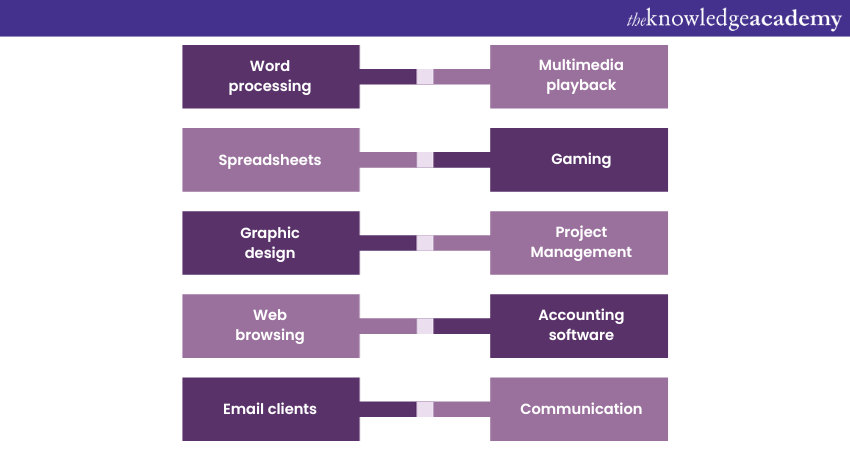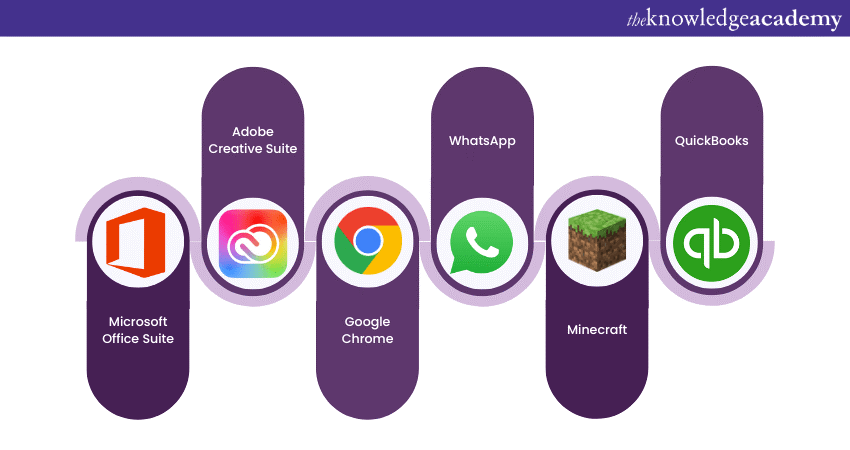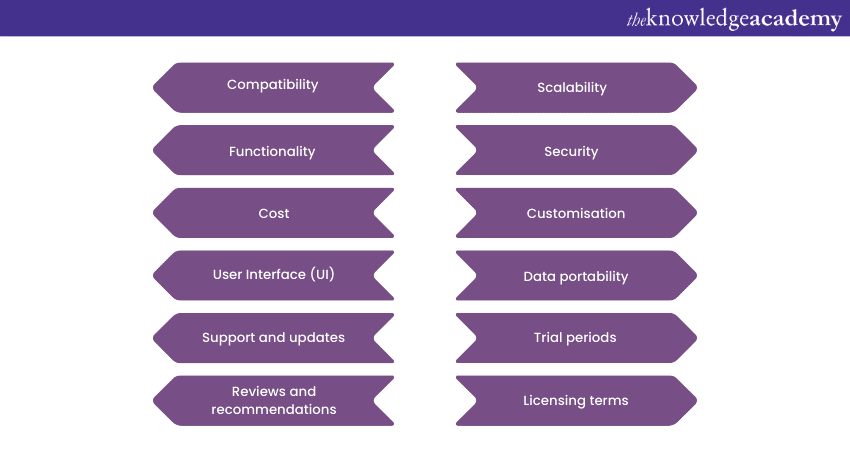We may not have the course you’re looking for. If you enquire or give us a call on 01344203999 and speak to our training experts, we may still be able to help with your training requirements.
Training Outcomes Within Your Budget!
We ensure quality, budget-alignment, and timely delivery by our expert instructors.

With the advancements in computing technology and the ever-increasing reliance on computer applications in daily life, Application Software has grown to be one of the most vital pillars of digital technology and ecosystem. Its functions, varied types and advantages have made it a reliable companion for professionals across domains. In this blog, we will tell you all about What is Application Software, its functions, advantages and disadvantages, as well as factors to consider when choosing an application.
Table of Contents
1) What is Application Software?
2) Functions of Application Software
3) Examples of Application Software
4) Advantages and disadvantages of Application Software
5) Factors you should consider when choosing Application Software
6) Conclusion
What is Application Software?
Application Software, often referred to simply as "apps" or "programs," is a class of software specifically designed to perform various tasks and functions for end-users. Unlike system software, which manages the computer's hardware and offers a platform for other software to run on, Application Software serves a more user-centric purpose. It enables users to perform specific tasks, such as word processing, graphic design, or playing games.
Unlock your potential in Software Engineering – sign up today for our Software Engineering Training!
Functions of Application Software
Application Software, the lifeblood of modern computing, serves a multitude of functions, each designed to streamline specific tasks and enhance user experiences. Let's explore these functions in greater detail, with each section providing an insight into the significance and impact of various Application Software categories.

Word processing
Word processing software revolutionises document creation. It empowers users to craft and edit text documents with remarkable flexibility. From creating professional reports to drafting personal letters, it enables precise formatting, spell-checking, and seamless collaboration.
Spreadsheets
Spreadsheets are the backbone of data management and complex calculations. Excel, for instance, simplifies financial analysis, inventory tracking, and statistical computations. It offers formulae, charts, and pivot tables for in-depth data manipulation.
Graphic design
Graphic design software like Photoshop unlocks the world of visual creativity. Artists and designers employ it for image manipulation, photo retouching, and crafting captivating digital art. It provides advanced tools for precise editing and design work.
Web browsing
Web browsers are our gateway to the large expanse of the internet. Chrome and Firefox, among others, offer rapid page loading, secure browsing, and a plethora of extensions for customising the online experience.
Email clients
Email clients are communication hubs. Outlook and Thunderbird streamline email management with features like categorisation, scheduling, and integration with calendars. They enhance productivity in both personal and professional settings.
Multimedia playback
Multimedia players like VLC and Windows Media Player provide immersive audio and video experiences. They support various file formats, subtitles, and streaming capabilities, transforming computers into entertainment hubs.
Gaming
Gaming applications offer diverse experiences, from action-packed adventures to brain-teasing puzzles. They leverage high-end graphics and interactivity, providing hours of entertainment for gamers of all ages.
Project Management
Project management software, exemplified by Microsoft Project, is a lifeline for effective planning and execution. It facilitates task scheduling, resource allocation, and progress tracking, which is crucial for project success.
Accounting software
Accounting software like QuickBooks simplifies Financial Management for businesses. It automates tasks like invoicing, expense tracking, and payroll processing, ensuring financial accuracy and compliance.
Communication
Communication applications like WhatsApp and Skype transcend geographical barriers. They offer instant messaging, voice and video calls, and group chats, fostering seamless interaction for individuals and teams.
Unlock the world of software design and architecture with our comprehensive Software Design And Architecture Training – elevate your skills today!
Examples of Application Software
The following are some relevant examples of commonly used Application Software:

Microsoft Office Suite
Microsoft Office Suite is a cornerstone of productivity software, offering a trio of essential applications. Microsoft Word is a versatile word-processing tool that empowers users to create documents of all types, from essays to professional reports, with features such as formatting, spell-checking, and collaborative editing. Microsoft Excel excels in data management, allowing users to build complex spreadsheets for tasks like financial analysis and inventory tracking. Lastly, Microsoft PowerPoint is the go-to application for crafting dynamic presentations, enabling users to convey ideas visually through slides, animations, and multimedia elements.
Adobe Creative Suite
Adobe Creative Suite, now known as Adobe Creative Cloud, is a powerhouse of creative software applications that have revolutionised design, multimedia, and content creation. It encompasses a diverse array of tools, including Photoshop, Illustrator, InDesign, and Premiere Pro. Photoshop is the go-to for image editing and manipulation, while Illustrator excels in vector graphics. InDesign is the premier choice for layout design, and Premiere Pro is a leading video editing software.
Google Chrome
Google Chrome stands as one of the most widely used web browsers globally. Known for its speed, stability, and minimalist design, Chrome provides a seamless internet browsing experience. It offers robust features like tab management, bookmark syncing, and cross-device integration through Google accounts. Chrome also boasts a vast library of extensions, enhancing its functionality with tools for productivity, security, and entertainment.
WhatsApp has revolutionised communication, bridging geographical gaps with instant messaging, voice calls, and video chats. This messaging application prioritises privacy and end-to-end encryption, ensuring secure conversations. Users can create group chats, share multimedia content, and make international calls without incurring hefty fees. WhatsApp's widespread adoption has made it a staple for personal and professional communication.
Minecraft
Minecraft is an exemplar of gaming software, renowned for its open-world sandbox gameplay. Players are immersed in a blocky, procedurally generated world where they can mine resources, build structures, and embark on adventures. Its limitless creativity and multiplayer capabilities have fostered a dedicated player base, with educational versions also utilised for teaching purposes, making it not just a game but a platform for exploration and learning.
QuickBooks
For businesses, QuickBooks serves as a vital tool for Financial Management. This accounting software streamlines tasks like invoicing, expense tracking, and payroll processing. It simplifies bookkeeping for small and medium-sized enterprises, ensuring financial accuracy and compliance. QuickBooks offers a range of editions, from self-employed individuals to larger enterprises, making it adaptable to businesses of all sizes and industries.
Advantages and disadvantages of Application Software
Application Software, with its diverse range of functions and capabilities, plays an integral role in our digital lives. However, like any tool, it comes with its own set of advantages and disadvantages. Let's explore these in detail:
Advantages of Application Software
The following are some advantages of Application Software:
1) Enhanced productivity: Application Software streamlines tasks, making them more efficient and less time-consuming. For example, word processing software automates formatting, saving users hours of manual effort when creating documents.
2) Specialisation: One of the key benefits of Application Software is its specialisation. Users can choose software tailored to their specific needs. This ensures that the software they use is optimised for the task at hand, whether it's graphic design, accounting, or project management.
3) Improved creativity: Many Application Software tools are designed to foster creativity. Graphic design software, for instance, provides a platform for artists and designers to bring their vision to life. This encourages innovation and artistic expression.
4) Convenience: Application Software simplifies complex processes, making them accessible to users with different levels of expertise. This convenience is particularly important in a world where technology plays an ever-expanding role in our daily lives.
5) Scalability: Application Software often offers the advantage of scalability. Businesses can start with a basic version of the software and then scale up as their needs grow. For example, a small business may begin with a simple accounting software package and later transition to a more comprehensive solution as it expands. This scalability ensures that the software can adapt to changing requirements without the need for a complete overhaul.
6) Collaboration and connectivity: Many Application Software tools are designed with collaboration in mind. They offer features that enable users to work together seamlessly, even if they are geographically dispersed. For instance, cloud-based office suites like Google Workspace facilitate real-time collaboration on documents, enabling multiple users to edit and comment on files simultaneously. This connectivity promotes teamwork and productivity, especially in today's global and remote work environments.
Disadvantages of Application Software
The following are some disadvantages of Application Software:
1) Cost: High-quality Application Software can be expensive. Licenses, subscriptions, and upgrades can add up, making it a significant investment for individuals and businesses. This cost can be a barrier to access for some users.
2) Compatibility issues: Not all Application Software is universally compatible. Some software may work seamlessly on one operating system but encounter challenges on another. Similarly, hardware limitations can restrict the use of certain software.
3) Security risks: Security is a significant concern with Application Software. Malicious software, commonly known as malware, can compromise the integrity of a system or steal sensitive data. Users need to be vigilant and use reputable software from trusted sources to mitigate these risks.
4) Learning curve: Complex Application Software often has a steep learning curve. Users may need to invest time and effort in learning how to use the software effectively. This initial learning period can slow down productivity.
5) Maintenance and updates: Application Software requires regular maintenance and updates to remain secure and functional. Users need to ensure they keep their software updated, which can be time-consuming and occasionally disruptive.
6) Resource intensive: Some Application Software can be resource-intensive, requiring powerful hardware to run smoothly. This can be a disadvantage for users with older or less powerful devices, as they may experience performance issues.
Unlock your potential in software development with our comprehensive Software Development Lifecycle Training – begin on a journey to excellence today!
Factors you should consider when choosing Application Software
The following are some factors you need to consider before you choose the Application Software that best suits your needs:

Compatibility
Compatibility encompasses both the Operating System (OS) and hardware requirements of the software. Different applications may work optimally on specific OSs (e.g., Windows, MacOS, Linux) or require certain hardware specifications (e.g., processor speed, RAM). Ignoring compatibility can result in software that runs slowly, crashes, or doesn't work at all on your system. To avoid such issues, double-check and ensure that the software is a good fit for your setup.
Functionality
The heart of the matter is whether the software can effectively address your needs. To determine this, start by identifying your objectives and the tasks you intend to accomplish with the software. Create a detailed checklist of the features you require and compare them with the capabilities offered by the software. It's essential to find a match that not only meets your immediate needs but also accommodates future requirements.
Cost
The financial aspect is a vital consideration. Different software applications come with various pricing models, and it's essential to understand them fully. This includes one-time purchase costs, subscription fees, or free versions with limited functionality. Take into account your budget constraints and evaluate whether the software's pricing aligns with the value it brings. Remember to factor in any ongoing costs, such as subscription renewals, to ensure that the software remains sustainable.
User Interface (UI)
The User Interface significantly influences your interaction with the software. An intuitive, well-designed UI can enhance productivity and user satisfaction. On the other hand, a badly designed interface can lead to frustration and meddle with your ability to effectively use the software. If possible, explore the software's UI through demos, trials, or screenshots to assess whether it matches your preferences and workflow.
Support and updates
Robust customer support and regular software updates are crucial for a smooth user experience. Investigate the support options provided by the software vendor, such as documentation, forums, or direct helpdesk assistance. Additionally, check the software's update frequency to ensure that it remains secure and up-to-date, safeguarding against vulnerabilities.
Reviews and recommendations
Leverage the experiences of others to gain valuable insights into the software's performance and reliability. Reading user reviews on reputable platforms and seeking recommendations from colleagues or industry peers can provide a well-rounded perspective. These real-world experiences can highlight both the software's strengths and potential weaknesses.
Scalability
As your needs evolve, it's crucial to choose software that can scale alongside your growth. Scalability ensures that you won't outgrow the software quickly and need to transition to a new solution. Assess whether the software accommodates additional users, data, or features, allowing it to remain a valuable asset as your requirements expand.
Security
Security is paramount, particularly when handling sensitive data or communications. Evaluate the security features offered by the software, such as data encryption, multi-factor authentication, and protection against malware. Additionally, look into the vendor's track record in addressing security vulnerabilities and their commitment to maintaining a secure environment.
Customisation
Consider whether the software allows for customisation to tailor it to your specific needs. Customisation can be particularly valuable for businesses with unique workflows or industry-specific requirements. Ensure that the software offers flexibility in adapting to your distinct processes.
Data portability
Data portability is essential for preventing vendor lock-in and ensuring that you can migrate to another software solution if necessary. Investigate whether the software allows for easy importing and exporting of data in standard formats. This feature ensures that your data remains accessible and transferable.
Trial periods
Whenever possible, take full advantage of trial periods or demos provided by software vendors. These opportunities allow you to test the software in a real-world context, assess its functionality, and evaluate its suitability for your needs. It's an excellent way to gain practical experience with the software before making a commitment.
Licensing terms
Thoroughly review the licensing terms and conditions of the software. Ensure that you understand the usage rights, restrictions, and any obligations associated with the software's licensing. Complying with licensing agreements is essential to avoid legal issues.

Conclusion
In our increasingly digitised world, Application Software stands as an indispensable ally, enhancing the way we work, communicate, create, and entertain. Its versatility, coupled with a vast array of functions, has revolutionised our modern existence. Hope we could answer all your queries about “What is Application Software?”!
Frequently Asked Questions
Upcoming Programming & DevOps Resources Batches & Dates
Date
 Systems Engineering Training
Systems Engineering Training
Fri 26th Jul 2024
Fri 25th Oct 2024
Wed 5th Mar 3034







 Top Rated Course
Top Rated Course


 If you wish to make any changes to your course, please
If you wish to make any changes to your course, please


